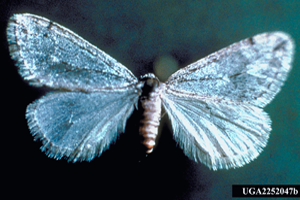|
Do you see/hear...?
|
| Activity
|
Adults
One or more adults are seen or heard moving about or at rest. For Alsophila pometaria, females are brownish-gray, wingless and cannot fly, while males have brownish-gray, glossy wings crossed with irregular bands and fly in search of females.
More...
For abundance, enter the number of individual animals observed in this phenophase.
|
| Reproduction
|
Mating
A male and female are seen coupled in a mating position, usually end to end. This can occur at rest or in flight. For Alsophila pometaria, females are flightless so mating does not occur in flight.
For abundance, enter the number of individual animals observed in this phenophase.
|
|
|
Egg laying
A female is seen laying eggs on a plant or other surface. If possible, record the name of the plant or describe it in the comments field. For Alsophila pometaria, eggs are deposited on twigs and small branches of trees.
For abundance, enter the number of individual animals observed in this phenophase.
|
|
|
Eggs
One or more eggs are seen on a plant or other surface. If possible, record the name of the plant or describe it in the comments field. For Alsophila pometaria, the tiny, barrel-shaped, grayish-brown eggs, each with a dark line around the rim and dark spot on top, are deposited in compact rows on a twig or small branch. Do not include empty eggs after the caterpillars have chewed their way out.
For abundance, enter the number of individual animals observed in this phenophase.
|
| Development
|
Caterpillars
One or more caterpillars (larvae) are seen moving about or at rest. When seen on a plant, if possible, record the name of the plant or describe it in the comments field. For Alsophila pometaria, caterpillars are "inchworms" or "loopers" with three pairs of forelegs and three pairs of stumpy "legs" (prolegs) on the back half of their body, one pair much shorter than the other two pairs. They may by pale green with faint white stripes down their sides, or they may be brownish-green with a black stripe down their back.
For abundance, enter the number of individual animals observed in this phenophase.
|
|
|
Caterpillars feeding
One or more caterpillars are seen feeding. If possible, record the name of the species or substance being eaten or describe it in the comments field. For Alsophila pometaria, caterpillars feed on the leaves of trees.
For abundance, enter the number of individual animals observed in this phenophase.
|
|
|
Dead adults
One or more dead adults are seen.
For abundance, enter the number of individual animals observed in this phenophase.
|
|
|
Dead caterpillars
One or more dead caterpillars are seen.
For abundance, enter the number of individual animals observed in this phenophase.
|
| Method
|
Individuals at a light
One or more individuals are seen at a light, whether flying or at rest.
For abundance, enter the number of individual animals observed in this phenophase.
|
|
|
Individuals in a net
One or more individuals are seen caught in a net.
For abundance, enter the number of individual animals observed in this phenophase.
|
|
|
Individuals in a trap
One or more individuals are seen caught in a trap.
For abundance, enter the number of individual animals observed in this phenophase.
|
